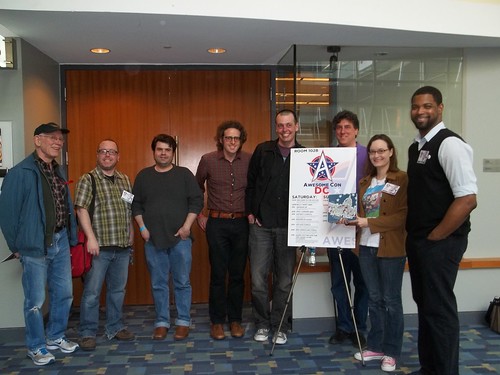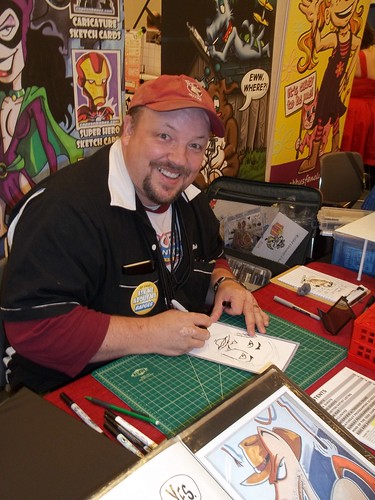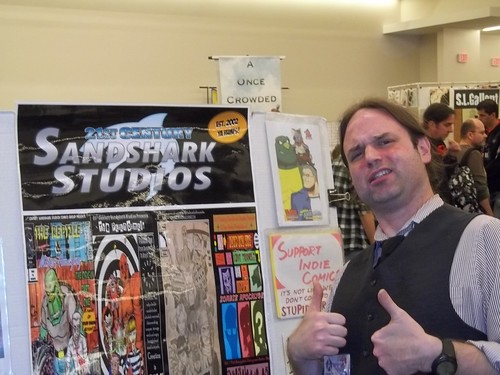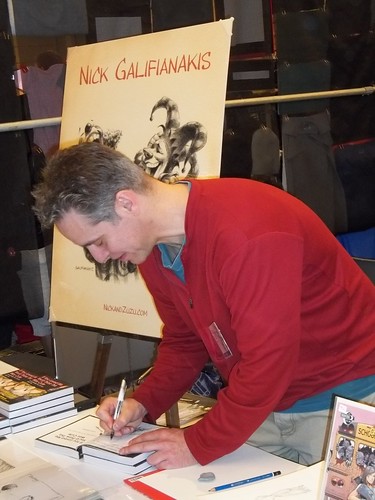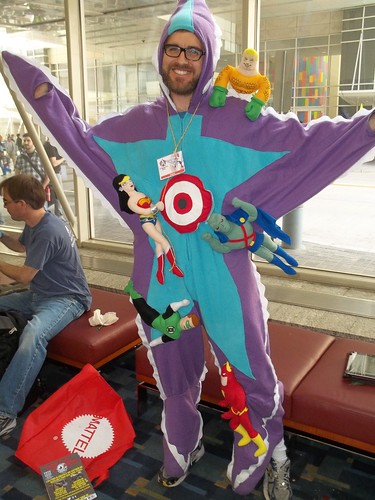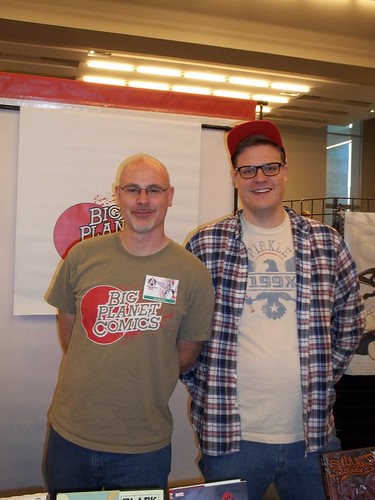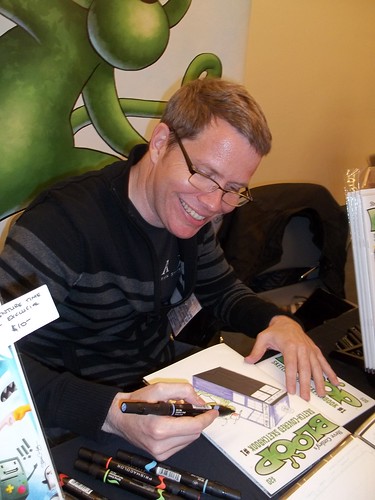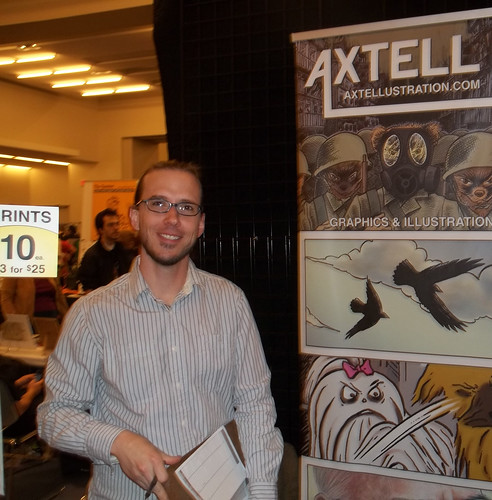
by Mike Rhode
The second book in the historical non-fiction short story anthology Colonial Comics was released this week. I met with editor Jason Rodriguez at Lost Dog Café in South Arlington and we chatted a bit about putting both books together. I hadn't gotten a copy yet, so the discussion is a bit abstract regarding the second volume, but hopefully our talk and some pictures from the book will hold your interest, dear reader. You can also check out this 2015 interview on book one from the Washington City Paper.
JR: It’s funny that the second book in the Colonial Comics series is
actually thicker than the first one. They changed the paper stock, and the second
actually has more pages. The covers are supposed to be continuous. [The first
book] has the Massachusetts coastline, the Mayflower coming in, a bunch of
Pilgrims parked on the shore, and one Native American overlooking it. The
second continues with the same shoreline, but now built up to Boston and more
ominously, with the British fleet coming in. When we do a mid-Atlantic version,
the drawing is going to continue South (i.e. lower in the cover).
MR: Are there any more books in the New England series?
JR: No more. We’re going to cut it off at the Revolution,
partly because a lot of people know about the American Revolution. They learned
about it in school.
MR: There’s always more, smaller stories…
JR: Absolutely. There’s plenty we could do, but as far as
Colonial Comics, the idea was always to go up to the Revolution. Otherwise, it
would be Revolutionary Comics. We wanted to focus on the origins of the
country.
MR: Are you planning on working your way to the South now?
 JR: The third book is supposed to be mid-Atlantic history.
We don’t have any plans to start it immediately. With the first book, we put it
out there and started working on the second book. We got feedback on the first
that we incorporated into the second, but we want get new feedback before we
start thinking about the third book. I wouldn’t expect us to start working on a
third book for six months or so.
JR: The third book is supposed to be mid-Atlantic history.
We don’t have any plans to start it immediately. With the first book, we put it
out there and started working on the second book. We got feedback on the first
that we incorporated into the second, but we want get new feedback before we
start thinking about the third book. I wouldn’t expect us to start working on a
third book for six months or so.
MR: Fulcrum is enthusiastic about the line?
JR: Yes, although the first book didn’t sell quite as well
as either of us wanted it to. When we go to a new printing of the book, we’ll
make some changes. The second book is strong and addressed feedback we got from
the first book, and should take off quicker. The first one sold fine; it just
didn’t sell fantastically.
MR: I think part of the problem with the first book to a
certain degree might be the amount of religion that’s a part of the early
American colonies – it’s hard to get away from, it’s hard to understand, and
it’s far removed from our culture.
JR: Yes, that led to a structural problem with the stories
themselves, because from 1620-1750, people know the landing at Plymouth and the
witch trials, and when we try to fill in the spaces, a lot of it is based on
religion and is dark stuff, like wiping out populations. And for a lot of it,
we have to use primary sources because it’s not covered in a book that we can
turn to. Because of that we ended up getting a lot of text-heavy stories that
was aimed at an adult audience, but marketed to middle-graders and young
adults. With the new book, I was much better at keeping people doing things
that feel like comics with actual
actions and not just captions everywhere. I think we took a lot of issues with
the first book to heart and came up with something much more fantastic.
MR: Did you use mostly the same contributors?
JR: No. There are some repeats. I have my people that I love
working with. John Bell and David Lewis are back as assistant editors. They
both also wrote a story. There’s a lot of our DC-area folks – Jason Axtell
colored a story in the first book, but he illustrated a story this time. Matt
Dembicki’s back. Scott White did the cover again, and this time he also did a
comic story. Chris Piers, even though he’s out in Seattle now. [Being
interviewed in a bar, Jason overlooked Arsia Rozegar, Mal Jones, Matt Rawson, Rafer
Roberts, and Carla Speed McNeil who also contributed]. I always use Charles
Fetherolf, Josh O’Neill and James Comey. I loved working with E.J. Barnes and
Sara Winifred Searle in the first volume
so I invited them back. Jason Hanley has always been my letterer but for the
most part I brought a lot of new people on board.
MR: How do you find people?
JR: We had a general call for submissions that several
people responded to, including some great finds. That’s probably where Jackie
Roche came from and she is phenomenal. She does these fantastic watercolors.
Just like with the first book, I wanted to focus on under-represented
narratives, unknown stories, things like that, but I still wanted to touch on
some of the big stories that we know.
I wanted to include the Boston Tea Party in some way, and Jackie came to me with a pitch about actually tracing the tea trade – starting in China, following it through India, and then into Massachusetts and tracing the tea as it went into the harbor.
I wanted to include the Boston Tea Party in some way, and Jackie came to me with a pitch about actually tracing the tea trade – starting in China, following it through India, and then into Massachusetts and tracing the tea as it went into the harbor.
A lot of the stories are ones I just found. Ashley Victoria
Robinson wrote “Mercy Otis Warren” about the playwright, and one by nature I
guess, because there were no plays in Boston. It was against Puritanical rules
to produce plays. Warren wrote revolutionary plays, originally anonymously, but
later took credit for them. Ashley wrote me saying she wanted to do a story
about nurses in the Revolutionary War, which we weren’t covering, but since
Ashley also had some playwriting experience, I suggested Warren.
Some people I paired with a topic, and some people came in
with great things. Kevin Cooney came through the submission process with a
story about the Stamp Act obelisk which I think is one of the greatest things I
learned. Matt Dembicki illustrated it. When the Stamp Act was repealed, Paul
Revere designed this obelisk which was supposed to be a permanent fixture under
the Liberty Tree. The problem was that it was made out of oiled paper and wood,
and it was lit from the inside with candles and
they put fireworks on top of it, so it burned down the first night they
celebrated it. Paul Revere’s plates still survive and I actually made an
origami version of it for promotion purposes so you could print it out and fold
it.
MR: Do you have an editor at Fulcrum?
JR: Yes, Fulcrum assigns me a chain of editors. Rebecca
McEwen edits for content and what’s allowed and what’s not in these books. It’s
not just sex and violence but language. There are two stories where I had to
put a disclaimer noting that “negro” and “mulatto” were common terms. We had to
cut out “damns.” There was a little pushback at times from the artists, but we
managed to sustain most of it. The copy editor was Alison Auch and she was
great to work with. She was very responsive and helped put the book together.
She worked really hard in the last month, because I was late in delivering
everything. But I do all the design work including the cover and literally
deliver them an entire book, so they could just publish it as-is, but they
don’t. They fine-tooth-comb it, and have third party people read it, and put a
lot of effort into it.
MR: A few years ago, you did an Amazon-only Kindle
children’s book and you’re about to launch a Kickstarter campaign for that?
JR: “The Little Particle that Could” is a story about
particle physics and general relativity for kids. The original version followed
a graviton who was perfectly happy just spinning and pulling things down to
earth until a photon catches her eye and she decides to chase it, off the Earth
and into a black hole. We wanted to do a print edition that was a bit more
special so now we have a new colorist, and Jason Hanley is re-lettering it.
We’re hoping to do a hardcover with nice glossy stock, and then stretch goal to
a board book because I love them. We just need to raise $5000, and then $10,000
for the board book. I think it’s achievable.







